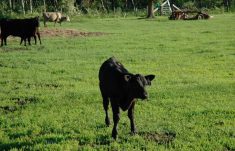It has always been my premise that spending a bit more time on specific cases during the calving season may reap benefits for those calves with ailments.
I know one must spend their time wisely at calving season, but even just keeping a cow-calf pair in isolation a bit longer may be all that is needed to secure the health of sa calf. Let’s look at few situations.
We all know the value of extra time spent making sure calves suck in order to get the precious colostrum, or making sure they are well bedded to prevent pneumonia, or having the calving area clean to prevent scours. These are all measures worth the extra effort. More live, better-doing calves result.
Read Also

Harvest wraps up and fall work begins
At the Eppich famly ranch in western Saskatchewan, the fall harvest was successful with few breakdowns, cows and calves have been sorted and a new tractor has arrived
You might also identify calves that may need a little more individual care early in life to make sure they get a good start. Larger, heavier birthweight calves are always slower to rise, and spending more time lying down can lead to developing an infection known as navel ill.
These bigger calves often are also the ones with slightly contracted tendons or legs that are rotated in or out, making it difficult to walk. Their tendons need to be stretched. To speed the process, calves can be given painkillers before applying some forceful stretching. One can also trim or rasp down the end of the toes to avoid knuckling of the foot. Trimming the hoof makes it easier for the calf to bear weight on the toes, which starts their own tendon-stretching process. Make sure calves so affected don’t need to walk too far to keep up with their mothers, as this is very tiring.
Calves are inquisitive, so make sure there isn’t plastic blowing through the pen or baler twine for them to chew on and swallow. These “software” products can cause problems such as gut blockages or indigestion. Minor issues such as ear infections can lead to pneumonias or head tilts, and antimicrobials at the right time may rectify this.
What’s causing lameness?
Much lameness in calves may be due to minor sprains or strains, but it’s worth checking their feet and legs if they are very lame. It could be due to anything from stepping on a rock or uneven surface, something imbedded in the bottom of the foot or even a broken leg. Treating them quickly can get them on the road to recovery.
If there is a break, lower-limb breaks can be cast successfully with a three- to four-week healing time. Higher-limb breaks may require a specific type of splint but very few are untreatable. It is important to get them checked out and attended to.
A producer might often find a calf that is gaunt and a bit dehydrated. It can be a bit hard to determine if this is a calf or cow issue, but regardless, the calf needs nourishment with either milk replacer or high-energy electrolytes.
As part of the treatment, have a close look at the calf to see if there is an underlying cause to decreased appetite, such as a low-grade navel infection, pneumonia or perhaps scours just starting. Each of these conditions generally comes with a different treatment plan.
On the other hand, the calf’s issue could be related to the cow. She could be sick from mastitis or a uterine infection (from being slow to lose her placenta). This hurts milk production and the calf suffers. Some cows have extremely hard teats that don’t release milk. If you have what appears as a starving calf, please check the cow’s udder.
Coming across a down cow is an obvious sign there is something wrong. It could be a veterinary emergency to determine the cause, so act quickly. No one likes seeing a cow down for any period — the longer they are down, the harder to get them up, even with treatment. Make sure they are on a well-bedded area and get the proper diagnosis and treatment plan. If a calcium, phosphorus or magnesium problem is identified in one cow, it may indicate others in the herd. Preventative measures can be taken for the rest.
Don’t assume anything
Calves that fail to thrive could lack colostrum but often other factors may be at play . I have seen calves affected by everything from a congenital heart problem, to a cleft palate, to being born with no rectum to part of their intestinal tract missing. These may go undetected for a few days and often there is very little we can do. I have often attempted surgery on those without a rectum, for example, sometimes successfully, sometimes not. It depends on several factors, but again, with many of these congenital defects, some can be fixed either temporarily or permanently. They are often very rewarding cases if the surgery works.
All these affected calves often need a few days with their mothers in a private pen. Disinfect the pen between uses and especially if the ailment is potentially contagious.
Let’s hope this extra care and attention can save you a few more calves that go on to be sold or raised to slaughter weight.















